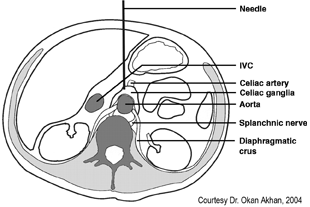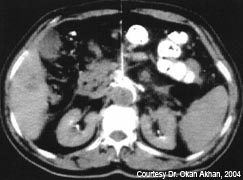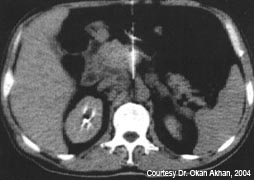Celiac Ganglion Block
Pain in cancer patients is a frequent chronic symptom that decreases the quality of life and restrict activities. Pain occurs in 90% of patients with advanced cancer. Control and palliation of pain is the principle aim of therapy in patients with inoperable cancer. Tumors originate from upper abdominal areas such as pancreas, stomach, duodenum, proximal bowel, liver, and biliary tract. These tumors may cause severe abdominal pain but often do not respond satisfactorily to medical treatment or radiotherapy. Percutaneous celiac ganglia block is a good alternative for patients with inoperable abdominal malignancy who need a high dose of energetics. Celiac ganglia block is performed via an anterior approach under CT guidance. We use a 22-gauge Chiba needle that enters the skin in the upper abdomen and reaches the pre-aortic area between the origin of the celiac trunk and the superior mesenteric artery just anterior to the abnormal aorta. A 50mm mixture of alcohol and contrast is injected. This mixture should be approximately 50% alcohol, 5% contrast, and the rest normal saline. Pain is expected to decrease significantly in approximately 95% of patients after the procedure. The main complication is the self-limiting diarrhea that occurs in up to 75% of patients. This is usually gone by 48 hours.
Reference:
Akhan O, Ozmen MN, Basgun N, Akinci D, Oguz O, Koroglu M, Karcaaltincaba M. Long-term results of celiac ganglia block: correlation of grade of tumoral invasion and pain relief. AJR Am J Roentgenol. 2004 Apr;182(4):891-6. [PubMed]



Back to list of procedures